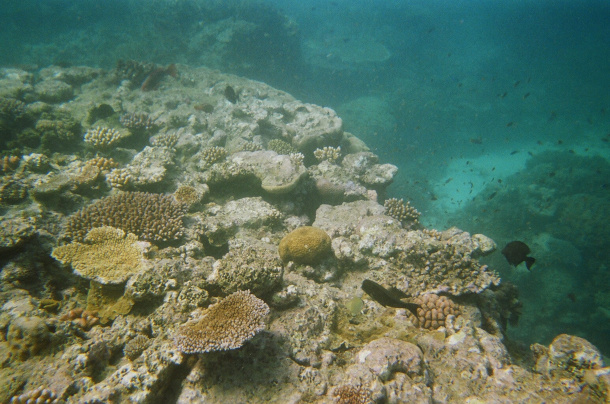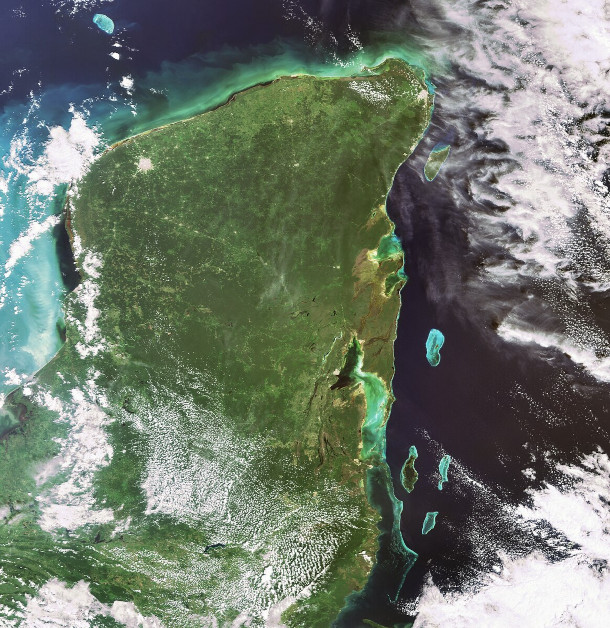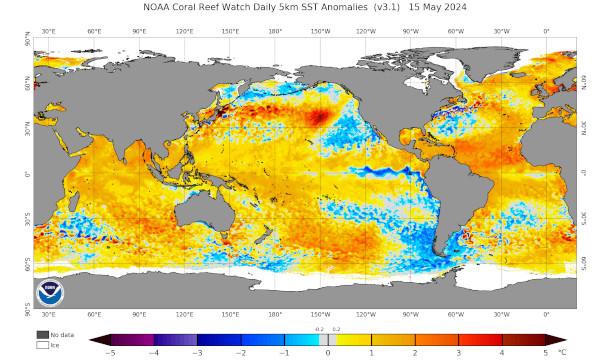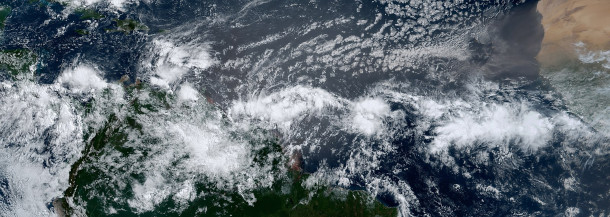Eco Grief Among Scientists
Air Date: Week of May 17, 2024

The Great Barrier Reef is the world's largest coral reef system, located in the Coral Sea off the coast of northeast Australia. (Photo: Jorge Láscar, Wikipedia Commons, CC BY 2.0)
2023 was the hottest year on record, at 1.48 degrees Celsius above preindustrial levels. That’s just below the 1.5 C increase that the UN says is the limit to avoid the worst impacts of climate change. As the summer of 2024 approaches in the Northern Hemisphere, climate scientists are raising the alarm on dangerous impacts of ongoing heat waves. Bob Berwyn from Inside Climate news joined Living on Earth’s Aynsley O’Neill to discuss ocean heat waves and profound grief among marine scientists.
Transcript
[THEME]
BELTRAN: From PRX and the Jennifer and Ted Stanley Studios at the University of Massachusetts Boston, this is Living on Earth. I’m Paloma Beltran.
O’NEILL: And I’m Aynsley O’Neill.
As summer approaches in the Northern Hemisphere, climate scientists are on high alert. 2023 was the hottest year on record, at 1.48 degrees Celsius above preindustrial levels. That’s just below the 1.5 Celsius increase that the UN says is the limit to avoid the worst impacts of climate change. But we’re already seeing the impacts in extreme heat, intensifying storms, and ongoing droughts. And the scientific community is not just concerned, but distraught. The Guardian conducted a poll of senior authors of the Intergovernmental Panel on Climate Change or IPCC reports. These experts produce recommendations on how to tackle the climate crisis. And out of some 400 responses, nearly 80% are expecting a rise of at least 2.5 degrees Celsius above preindustrial levels, a dangerous level of heating. Only 6% think we’ll be able to stay within the 1.5 Celsius limit. Damian Carrington is the Environment Editor of the Guardian. He spoke with several of these scientists.
CARRINGTON: The one that stuck with me was a brilliant climate scientist called Ruth Cerezo-Mota who's based in Mexico. She was talking about how she'd been at a meeting of the IPCC and started to really realize what the trajectory we’re on looks like, and what it means for people in terms of the damage to lives and livelihoods, and it kind of really shocked her. She was open with me, she said she got really depressed for quite a long time, she felt like she couldn't really do anything. But she eventually got over it and thought, actually, I've got to do my work.
O’NEILL: Ruth Cerezo-Mota is among the scientists who predict we’ll rise above 2.5C and she is living the impacts of climate change firsthand. Her home, the Yucatan Peninsula, is a tropical, humid area where last year temperatures reached a staggering 47 degrees Celsius amid one summer heat wave. That’s around 116 degrees Fahrenheit.

The Yucatán Peninsula is a large peninsula in the Gulf of Mexico and is the homeland of climate scientist Ruth Cerezo-Mota. Last year, the Yucatan Peninsula saw temperatures reach a staggering 47 degrees Celsius amid one summer heat wave. (Photo: Wikipedia Commons, CC BY-SA 3.0)
CARRINGTON: She was saying that undoubtedly many people had died early as a result of these heat waves. And she sat there thinking, well, all the work we're doing isn't making a difference. And she was really, really upset and was saying that she continues the work so that the people who are responsible for the change cannot say they didn't know. That was her kind of motivation. They may not do anything, but they can't say they didn't know.
O’NEILL: Damian also highlighted how despite the despair, scientists say we still have time.
CARRINGTON: Ruth’s story was far from the only one. There was a scientist called Henri Waisman from France. He was saying that he had feelings of guilt about not doing enough and how that had become even greater as he had become a father relatively recently. But he said that, you know, when he feels despairing, he thinks that climate change is a slow-motion disaster. It happens bit by bit, it's not a cliff edge. And the positive bit out of that is that every 10th of a degree is worth fighting for. Every bit you stop reduces that suffering to life and livelihoods around the world.
O’NEILL: The Guardian survey also asked, “What do you see as the number one barrier to action?”
CARRINGTON: So 75% of almost the almost 400 respondents to our survey said that lack of political will was the biggest barrier to climate action and matching that when we asked them about what are the most effective actions individuals can take, most of them said voting.
O’NEILL: But still, many of the effects of climate disruption are already in progress. One place getting hit especially hard is the ocean. According to the National Oceanic and Atmospheric Administration, the seas have absorbed more than 90 percent of the heat energy trapped by greenhouse gasses since the start of the industrial age. And just like with the IPCC scientists, marine scientists are overcome with grief and despair as their work suffers in the face of the climate crisis. For more, I’m joined now by Bob Berwyn, a journalist with our partner Inside Climate News who has been on the ocean beat for over a decade and has seen this eco-grief consistently throughout his reporting. Bob, welcome back to Living on Earth!
BERWYN: Hi, thanks for having me again, I appreciate it.
O'NEILL: So what are some of the impacts that scientists have been observing?

Jennifer Lavers is a coordinator of the marine research nonprofit Adrift Lab. She has been tracking how thousands of seabirds have starved to death during recent ocean heat waves off the coast of western Australia. (Photo: Luke Hosty)
BERWYN: Going back a few years, there have been quite a few mass die-offs of all different types of marine organisms. I think the first time that they were really well documented, going as far back as 2003 in the Mediterranean, when ocean scientists there looked at little what are called benthic organisms that live in shallow water in the seabed, mixed in with the sand and rocks, so little snails and tiny crustaceans, and documented really just an almost complete disappearance of some of these species after just one single marine heat wave. And then if you fast forward a few years, we've had heatwave conditions in the Pacific Ocean that have resulted or contributed to die-offs of marine mammals, some of which have starved to death, because the extraordinary heat in the ocean made their food supply go somewhere else, potentially, in some cases. There was a starfish die-off, which you all may have reported on a few years ago, that in some ways has been linked to very warm ocean conditions in the Pacific. And there have been mass mortalities of seabirds there as well. And other impacts include things like toxic algae blooms that in turn also affect animals. So there's been documented cases of fish and birds dying because they ate algae or crustaceans that had a toxic algae with them. And so the impacts are quite intense and quite widespread.
O'NEILL: And with these ocean heat waves, I saw you quote a statistic from a climate scientist in New Zealand. And it was some pretty scary stuff. Can you tell me a bit more about that?
BERWYN: Fifteen years ago, people weren't talking about marine heatwaves even that much because they only happened every once in a while and affected sort of a small area. You know I'd say really, in the last 10 years, they've started to spread so far, become so big and last so long that it's really hard for almost any ocean scientist to ignore them. So just a couple of weeks ago, the scientist Ben Noll in New Zealand calculated the extent of current marine heatwave conditions, and heatwave conditions extended across about a third of the world's ocean, which is as if you had heat waves across North America, South America, Europe and Asia all at the same time. So just huge, huge expanses.

The above map shows “Sea Surface Temperature” (SST) anomalies on April 29, 2024. A positive anomaly (yellow orange or red) means the current SST is warmer than average, and a negative anomaly (blue or purple) means it is cooler than average. (Photo: NOAA Coral Reef Watch, noaa.gov, Public Domain)
O'NEILL: During your reporting, you spoke with a scientist named Jennifer Lavers who studies seabirds. What did she have to tell you?
BERWYN: Well, she's been studying around Western Australia, she has been studying seabird colonies for a few decades, and has noticed that these ocean heat waves in the last years have really started affecting these seabird colonies. And she was quite distraught about it and says that she sometimes, when she describes her work to people, is now feeling like her research is now sort of documenting the extinction of the species that she studies, the flesh-footed shearwater. And it's just one of many ocean species, birds and others, that are really being affected by these ocean heat waves.
O'NEILL: Now Bob, you've been on this beat for some time, covering the ocean. What have you seen in terms of the progression of ocean health or, you know, perhaps lack thereof?
BERWYN: Many of the scientists—Jennifer isn't the only one that I spoke with—have a real sense of grief and sadness, watching this incredible living system sort of disintegrate in real time and just sort of unseen to a lot of people, because it's just below the surface of the waters. You know, it gets in the news when there's a huge fish die-off, then there's a day or two where you have front-page pictures on websites and newspapers if there's just this huge expanse of, of dead fish. This kind of stuff has gone on in the ocean all the time, just most of the time nobody sees it, and it's really a big dying. And you know, there have been studies in the last couple of years warning that we're headed in the direction of some of the greatest mass ocean extinctions known from the fossil record. So for looking at fossils, we can tell, wow, at this time when the earth warmed really quickly 350 million years ago, more than 90% of all organisms in the ocean died. And we're not there. We're not at that point yet. But these are studies saying we are headed in that direction.
O'NEILL: Now here in the northern hemisphere, summer is right around the corner. And so we're keeping our eyes on the hurricane season that's about to start in the tropical North Atlantic. And one of the key factors in hurricane formation is, of course, sea surface temperature. What have you been hearing about the consequences of ocean heat waves on these massive storms?

The Main Development Region (MDR), located in the Atlantic Ocean, is the area where most Atlantic tropical cyclones form. Researchers tracking marine heat waves in the MDR, as the summer of 2024 is now just starting, say that record ocean heat is a key ingredient in their projections for a very active hurricane season. (Photo: Wikipedia Commons, Public Domain)
BERWYN: Good question. The part of the Atlantic that you're talking about is also called by hurricane experts the main development region, that belt of the Atlantic between Africa and the, and the Caribbean. And what some hurricane scientists have been writing about and posting about on social media is that this area is as warm now as it usually is in mid-July, when the hurricane season really starts kicking into high gear. And they're pointing out that, combined with some other factors, this heat is a warning sign that the hurricane season could be very, very active this year. And there's plenty of research from the last few years showing that the warmer the oceans are, the stronger the hurricanes can be. And that they pick up also extra moisture, because the warmer atmosphere holds more moisture. So when some of these storms come ashore, there have been climate attribution studies showing that certain hurricanes dropped a certain percentage more precipitation than they would have in a cooler climate. So all told, this extreme warmth and long lasting heat wave over that part of the Atlantic is a warning that we could be in for a really severe hurricane season. And this part of the Atlantic has been sort of record warm for months and months. And, you know, at times, it kind of calls into question whether a heat wave is really the right name anymore, because when you think of a heat wave on land, you think of an event that has a certain start date and an end date, right, like, Wow, that last summer's heat wave was a doozy, it lasted two weeks or, but these things in the ocean are going on for weeks and months, so...
O'NEILL: Bob, what was your takeaway from the scientists you spoke with here? You know, what was the common sentiment among them?

Bob Berwyn is an Austria-based reporter who covers climate science and international climate policy for InsideClimate News. (Photo: Courtesy of Bob Berwyn)
BERWYN: I think they're waving again and have been for a while, a huge red flag about the threat of global warming to marine life very, very broadly. And thus, the threat to people, because these are changes that potentially will threaten food supplies. When we talk about ocean heat waves, the projections for the tropical oceans are that by the end of the century, that they will be so warm, that there will hardly be any fish at all in the world's tropical oceans. There aren't any fish that are adapted to the temperatures that are projected for the band of tropics just north and south of the equator. And evolution doesn't happen that fast. It's not like a new species of fish can evolve within, you know, seventy years to fill that ecological niche. And so you're gonna have like a lot of people, millions of people living in tropical zones, who are going to lose an important source of food. So my main takeaway from talking to a lot of these scientists is that we need to stop global warming and hopefully slow the warming of the oceans, too, and slow this trend of more and more heat and more and more extreme heat in the oceans that is really damaging these ecosystems.
O'NEILL: Bob Berwyn is a journalist with Inside Climate News. Bob, thank you so much for joining me today.
BERWYN: You're welcome. Thanks.
Links
The Guardian | “World’s Top Climate Scientists Expect Global Heating to Blast Past 1.5C Target”
The Guardian | “‘The Stakes Could Not Be Higher’: World Is on Edge of Climate Abyss, UN Warns”
The Guardian | “‘Hopeless and Broken’: Why the World’s Top Climate Scientists Are in Despair”
Learn more about Damien Carrington
Learn more about Ruth Cerezo-Mota:
Learn more about Henri Waisman:
Living on Earth wants to hear from you!
Living on Earth
62 Calef Highway, Suite 212
Lee, NH 03861
Telephone: 617-287-4121
E-mail: comments@loe.org
Newsletter [Click here]
Donate to Living on Earth!
Living on Earth is an independent media program and relies entirely on contributions from listeners and institutions supporting public service. Please donate now to preserve an independent environmental voice.
NewsletterLiving on Earth offers a weekly delivery of the show's rundown to your mailbox. Sign up for our newsletter today!
 Sailors For The Sea: Be the change you want to sea.
Sailors For The Sea: Be the change you want to sea.
 The Grantham Foundation for the Protection of the Environment: Committed to protecting and improving the health of the global environment.
The Grantham Foundation for the Protection of the Environment: Committed to protecting and improving the health of the global environment.
 Contribute to Living on Earth and receive, as our gift to you, an archival print of one of Mark Seth Lender's extraordinary wildlife photographs. Follow the link to see Mark's current collection of photographs.
Contribute to Living on Earth and receive, as our gift to you, an archival print of one of Mark Seth Lender's extraordinary wildlife photographs. Follow the link to see Mark's current collection of photographs.
 Buy a signed copy of Mark Seth Lender's book Smeagull the Seagull & support Living on Earth
Buy a signed copy of Mark Seth Lender's book Smeagull the Seagull & support Living on Earth

